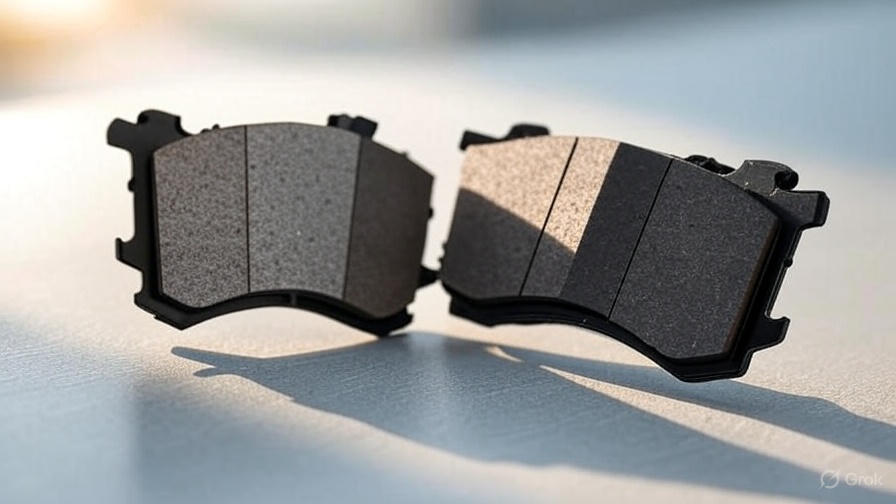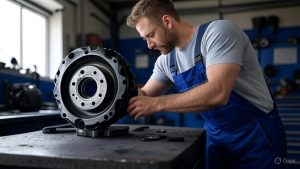When your vehicle’s brake pads approach the end of their service life, the decision between Akebono and Centric brake pads becomes a critical choice that affects your safety, comfort, and wallet. Both manufacturers have earned solid reputations in the automotive aftermarket, but they serve different needs and priorities.
This comprehensive comparison examines every aspect of these two leading brake pad brands. From stopping power and noise levels to dust production and longevity, we’ll break down the real-world performance differences that matter to drivers. Armed with detailed specifications, pricing analysis, and user experiences, you’ll make an informed decision that matches your driving style and budget.
Understanding Brake Pad Technology: The Foundation of Performance
Modern brake pads utilize advanced materials and engineering to transform kinetic energy into heat through friction. The composition of these materials directly impacts performance characteristics like stopping distance, fade resistance, noise generation, and dust production.
Brake pad compounds fall into several categories, with ceramic and semi-metallic formulations dominating the aftermarket. Ceramic pads blend ceramic fibers with copper, steel, and synthetic materials to create a compound that operates quietly with minimal dust. Semi-metallic pads incorporate iron, steel, copper, and graphite for enhanced heat dissipation and stopping power.
The manufacturing process also plays a crucial role. Precision backing plate design, proper chamfering, and quality control standards separate premium pads from budget alternatives. Both Akebono and Centric invest heavily in these areas, though their approaches differ significantly.
Akebono Brake Pads: Japanese Engineering Excellence
Akebono stands as one of the original equipment manufacturers for major automotive brands, bringing decades of OEM experience to the aftermarket. The company engineered ProACT® Ultra-Premium Ceramic Brake Pads to eliminate noise, vibration and harshness (NVH) for the smoothest, quietest and longest-lasting braking performance in the industry.
The Akebono product lineup targets different market segments through distinct product lines:
ProACT Series: The flagship ceramic brake pads deliver OEM-quality performance for Asian and domestic vehicles. Akebono ProACT® Ultra-Premium Brake Pads are the perfect replacement for restoring OE ceramic pad performance, providing Asian vehicles with superior stopping power, quiet braking, longer pad and rotor life, and ultra-low dust.
Performance Series: Designed for vehicles requiring enhanced stopping power, particularly trucks and SUVs used for towing. The Akebono Performance Ultra-Premium Ceramic Brake Pads are the ideal replacement for your worn-out stock, with their vehicle-specific ceramic formulation, these pads are the perfect upgrade you need for improved stopping power even under load.
EURO Series: Akebono EURO Brake Pads provide excellent stopping power, extend pad and rotor life, and virtually eliminate brake dust. They are the ultimate upgrade for semi-metallic and low-metallic brake pads.
The proprietary Akebono Ceramic Technology (ACT) formula sets these pads apart from competitors. This advanced ceramic compound delivers consistent friction coefficients across temperature ranges while minimizing wear on brake rotors.
Centric Brake Pads: American Value and Versatility
Centric Parts approaches brake pad manufacturing with a focus on delivering performance at accessible price points. The company offers multiple product tiers to serve different budget levels and performance requirements.
Posi-Quiet Series: The premium Centric brake pad line emphasizes noise reduction and smooth operation. Ultra-premium Posi-Quiet brake pads are designed to eliminate noise and vibration, with fade-free performance.
Premium Semi-Metallic and Ceramic: Centric Premium Ceramic Brake Pad compounds produce little brake dust and provide longer service than other brake pad formulas, with 100% Asbestos and Copper free formulas and Premium Centric semi-metallic and ceramic brake pads are formulated for reduced noise and long life.
C-TEK Standard: The entry-level offering provides reliable stopping power at budget-friendly prices. Standard C-Tek brake pads offer exceptional quality and value.
Centric’s strength lies in offering multiple formulations within each product line, allowing customers to select ceramic or semi-metallic compounds based on their specific needs and preferences.
Performance Comparison: Stopping Power and Feel
Real-world testing reveals distinct performance characteristics between these brands. Brake pedal feel represents one of the most noticeable differences during daily driving.
Akebono pads typically provide a firmer, more linear pedal response that closely mimics OEM characteristics. ProACT™ ceramic brake pads provide unrivaled “initial effectiveness” with no required break-in period and enhanced initial effectiveness (no break-in required), high resistance to fade, consistent brake pedal feel and ultra-low dusting.
Users report that Akebono pads deliver immediate bite without the spongy feel sometimes associated with aftermarket brake pads. There was an increase in stopping power, that initial bite was a definite improvement over the stock OEM pads, the brake pedal felt firmer and everything really felt positive.
Centric pads show more variation depending on the specific product line. Compared to OE, these pads are a bit “soft” for the first few stops when cold. After they warm up, the pedal feel and friction levels are very similar to OE – probably 85% identical.
Cold weather performance distinguishes these brands significantly. Akebono Performance pads rated GG for those that care, they took a long time to break it they perform well, they have a very consistent and linear response even in extreme conditions.
Temperature stability affects both brands differently. Ceramic formulations from both manufacturers resist brake fade better than semi-metallic alternatives, but Akebono’s proprietary compounds maintain more consistent friction coefficients across broader temperature ranges.
Noise, Vibration, and Harshness: The Comfort Factor
Brake noise ranks among the top complaints from vehicle owners, making NVH control a critical performance metric. Both manufacturers address this concern through different approaches.
Akebono’s engineering philosophy prioritizes noise elimination from the design phase. Akebono engineered ProACT® Ultra-Premium Ceramic Brake Pads to eliminate noise, vibration and harshness (NVH) for the smoothest, quietest and longest-lasting braking performance. The ceramic formulation naturally produces less noise than semi-metallic alternatives.
Advanced backing plate design, precision chamfering, and integrated shims contribute to noise reduction. These manufacturing techniques prevent vibration transmission between the brake pad and caliper, eliminating squeal before it starts.
Centric addresses noise through their Posi-Quiet line, which incorporates noise-dampening technology. Centric Posi Quiet Ceramic Brake Pads are very quiet and low vibration, as labeled, according to user reports.
The difference becomes apparent during cold starts and low-speed maneuvering. Akebono pads consistently operate silently across temperature ranges, while some Centric formulations may produce occasional noise during initial stops when cold.
Professional installation significantly impacts noise levels for both brands. Proper surface preparation, torque specifications, and break-in procedures determine long-term noise performance regardless of pad quality.
Dust Production: Keeping Your Wheels Clean
Brake dust accumulation affects both wheel appearance and long-term maintenance requirements. The composition and hardness of brake pad materials directly influence dust generation.
Akebono’s ceramic formulations produce minimal brake dust. ProACT Ceramic Pads provide ultra-low dusting for cleaner wheels and tires and Akebono’s discs and ultra-premium ceramic disc brake pads provide dust-free braking. This characteristic appeals particularly to owners of vehicles with expensive or difficult-to-clean wheel finishes.
The dust that Akebono pads do produce tends to be lighter in color and less adhesive than semi-metallic alternatives. This makes routine wheel cleaning easier and prevents permanent staining of wheel surfaces.
Centric brake pads show more variation in dust production depending on the specific formulation. Centric Premium Ceramic Brake Pad compounds produce little brake dust, while their semi-metallic options generate moderate dust levels typical of this material type.
For vehicles subjected to frequent washing or detailed regularly, the dust reduction benefits of premium ceramic formulations justify their higher cost through reduced maintenance time and wheel cleaning products.
Longevity and Wear Characteristics
Brake pad lifespan depends on multiple factors including driving conditions, vehicle weight, rotor condition, and maintenance practices. Both manufacturers design their premium products to match or exceed OEM service life.
The Bosch had 6mm of material, Centric had about ~7mm and the Akebono was probably 7.5mm in a direct thickness comparison. Initial pad thickness affects service life, with thicker pads generally lasting longer under identical conditions.
Akebono’s ceramic technology provides even wear patterns that maximize material utilization. The consistent friction characteristics prevent hot spots and uneven wear that can reduce effective pad life.
Wear indicator systems differ between brands. Only the Akebono’s had 2 pads with wear indicators, providing better monitoring of pad condition for safety and maintenance scheduling.
Rotor compatibility plays a crucial role in overall system longevity. Akebono’s OEM background ensures compatibility with original equipment rotors, potentially extending rotor life compared to more aggressive aftermarket formulations.
Centric offers different wear characteristics depending on product line selection. Their premium ceramic formulations rival Akebono for longevity, while budget options prioritize initial cost over extended service life.
Installation and Break-In Requirements
Proper installation procedures affect long-term performance for both brake pad brands. However, their break-in requirements differ significantly.
ProACT™ Ceramic Disc Pads provide unrivaled “initial effectiveness” with no required break-in period and Akebono’s discs and ultra-premium ceramic disc brake pads do not need to be broken in. This advantage allows immediate full performance without the gradual bedding process required by many aftermarket pads.
Centric brake pads typically require standard break-in procedures. This involves gradual heat cycling to properly mate the pad surface with the rotor. The break in procedure was pretty straight forward for most Centric applications.
Installation hardware varies between manufacturers. Akebono includes comprehensive shim kits and hardware with most applications, while Centric’s inclusion depends on the specific product line.
Professional installation remains recommended for both brands, particularly when replacing rotors simultaneously. Proper torque specifications, caliper service, and brake fluid inspection ensure optimal performance and safety.
Price Analysis: Value Propositions
Pricing structures reveal different market positioning strategies between these manufacturers. Understanding the cost-to-performance ratio helps justify the investment.
Akebono positions itself in the premium segment with prices typically 15-30% higher than comparable Centric offerings. The Centric pads can be had for $30 cheaper total for all four corners compared to Akebono pads.
This price difference reflects Akebono’s OEM heritage, advanced ceramic technology, and comprehensive testing. For vehicles still under warranty or luxury applications, the price premium may be justified by superior performance and longevity.
Centric’s tiered pricing structure accommodates different budgets. Their premium Posi-Quiet line competes directly with Akebono while offering modest savings. The C-TEK standard line provides significant cost advantages for budget-conscious consumers.
Cost per mile calculations often favor higher-quality pads despite greater initial expense. Extended service life, reduced rotor wear, and minimized maintenance can offset the premium pricing over the pad’s service life.
Application-Specific Recommendations
Different driving conditions and vehicle applications favor specific brake pad characteristics. Tailoring pad selection to actual usage patterns optimizes both performance and value.
Daily Commuting: Light-duty applications with frequent stop-and-go traffic benefit from Akebono’s smooth operation and minimal dust production. The immediate effectiveness without break-in requirements suits urban driving patterns.
Highway Cruising: Vehicles primarily used for highway driving can utilize either brand’s ceramic formulations effectively. Centric’s price advantage becomes more attractive when severe braking events are infrequent.
Towing and Hauling: Akebono Performance brake pads provide great stopping power when towing or hauling heavy loads. The enhanced thermal capacity and fade resistance justify the premium pricing for these applications.
Performance Driving: Enthusiast applications require careful consideration of friction coefficients and temperature ranges. Both manufacturers offer performance-oriented formulations, but specific compound selection becomes critical.
Fleet Applications: Commercial use often prioritizes cost-effectiveness over premium features. Centric’s standard lines provide reliable performance at attractive pricing for fleet maintenance budgets.
User Experience and Professional Insights
Real-world feedback from mechanics, fleet managers, and individual vehicle owners provides valuable insight into long-term satisfaction with both brands.
Professional technicians often prefer Akebono for premium vehicle applications due to consistent quality and OEM-like characteristics. The predictable performance and comprehensive hardware packages simplify installation and reduce comeback issues.
Fleet maintenance professionals report good experiences with both brands, though specific applications influence preferences. Centric’s pricing advantages appeal to cost-conscious operations, while Akebono’s longevity benefits high-mileage applications.
Individual vehicle owners express satisfaction with both brands, though expectations and priorities influence their assessments. Those prioritizing quiet operation and minimal maintenance tend to favor Akebono, while price-conscious buyers appreciate Centric’s value proposition.
Online forums and automotive communities provide extensive real-world testing data. Many people LOVE the Akebono pads, however, browsing other forums, others also like the Centric Ceramic pads, indicating satisfaction with both options.
Environmental and Regulatory Considerations
Environmental regulations increasingly affect brake pad formulations, particularly copper content restrictions in many jurisdictions. Both manufacturers have adapted their products to meet these requirements.
Akebono EURO® and Akebono Performance® Ultra-Premium Brake Pads have met low-copper regulations. And now, Akebono ProACT® Ultra-Premium Brake Pads meet low-copper requirements, too.
Centric Premium Ceramic Brake Pad compounds are 100% Asbestos and Copper free formulas, ensuring compliance with current and future environmental standards.
These regulatory changes don’t compromise performance but may affect formulation costs. Both manufacturers invest in research and development to maintain performance while meeting environmental requirements.
Disposal considerations also factor into long-term environmental impact. Ceramic pads from both manufacturers generate less harmful dust during use and pose fewer disposal challenges than older semi-metallic formulations.
Making the Final Decision
Selecting between Akebono and Centric brake pads requires evaluating your specific priorities, budget constraints, and vehicle requirements. Neither brand represents a poor choice, but each excels in different areas.
Choose Akebono when:
- Your vehicle requires OEM-equivalent performance
- Minimal brake dust is a priority
- You value immediate effectiveness without break-in
- Budget allows for premium pricing
- Vehicle is used for towing or heavy-duty applications
Choose Centric when:
- Initial cost is the primary concern
- Vehicle has standard braking requirements
- You’re willing to perform proper break-in procedures
- Multiple formulation options appeal to you
- Fleet or commercial applications require cost optimization
Both manufacturers stand behind their products with comprehensive warranties and technical support. Quality control standards ensure consistent performance across production batches.
Installation Tips and Best Practices
Regardless of your brake pad choice, proper installation techniques maximize performance and longevity. Both Akebono and Centric provide detailed installation instructions specific to their products.
Surface preparation becomes critical when switching between brands or pad types. Brake rotor surface conditioning ensures proper pad bedding and prevents noise or vibration issues.
Caliper maintenance during pad replacement prevents premature wear and performance issues. Cleaning caliper pins, inspecting rubber boots, and lubricating contact points optimize system operation.
Brake fluid inspection and potential replacement should coincide with pad installation. Contaminated or aged brake fluid compromises both performance and component longevity.
Long-Term Maintenance Considerations
Both brake pad brands require similar maintenance approaches, though their specific characteristics influence inspection intervals and replacement indicators.
Akebono’s consistent wear patterns simplify maintenance scheduling. The minimal dust production and smooth operation provide clear indication of pad condition without frequent disassembly.
Centric pads may require more frequent inspection, particularly during break-in periods. Monitoring for proper bedding and even wear patterns ensures optimal performance throughout the pad’s service life.
Rotor maintenance becomes crucial with either brand. Regular inspection for scoring, warping, or uneven wear prevents premature pad replacement and maintains braking performance.
Conclusion: The Verdict
After examining every aspect of these brake pad brands, the choice ultimately depends on your individual priorities and circumstances. Akebono delivers premium performance with OEM-equivalent characteristics, justifying its higher cost through superior noise control, minimal dust production, and immediate effectiveness. The brand excels in applications requiring consistent performance and minimal maintenance.
Centric provides excellent value through multiple product tiers that accommodate different budgets and requirements. Their premium lines compete effectively with Akebono while offering cost savings, and their standard options serve budget-conscious consumers without compromising essential safety performance.
For most drivers, either choice will provide safe, reliable braking performance that exceeds their current brake pads. Consider Akebono for premium applications where performance and convenience justify the cost premium. Choose Centric when budget constraints are important but you still want quality aftermarket performance.
Both manufacturers continue investing in research and development, ensuring their products evolve with changing vehicle technologies and regulatory requirements. Your decision today positions you well for years of reliable braking performance, regardless of which brand you ultimately select.
The key lies in matching the brake pad’s characteristics to your actual driving needs rather than pursuing maximum performance for applications that don’t require it. Both Akebono and Centric offer solutions that will serve you well when properly matched to your vehicle and driving requirements.




